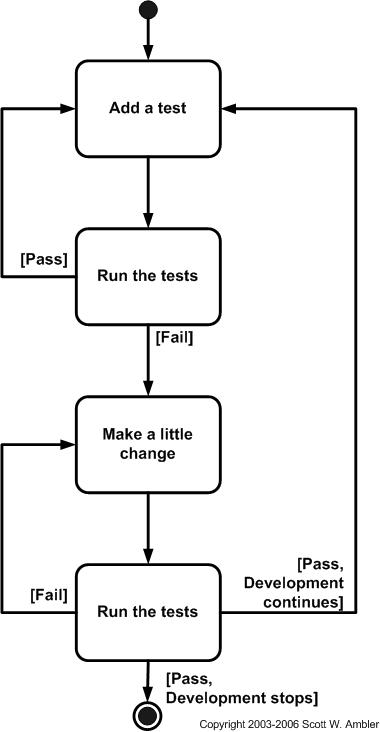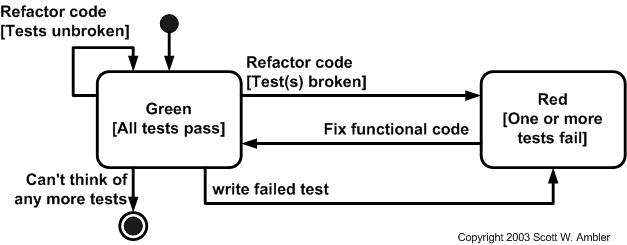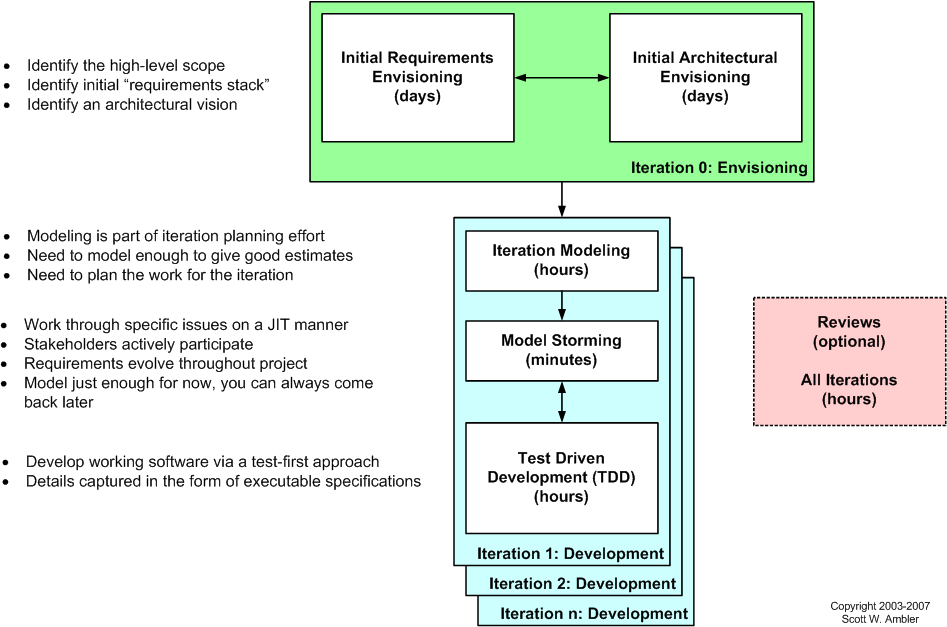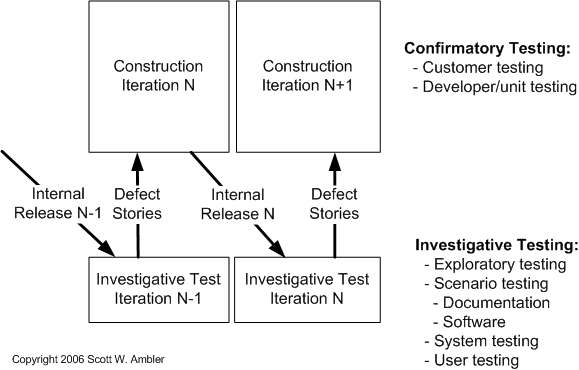| Test-driven
design (TDD) (Beck 2003; Astels 2003), is an evolutionary
approach to development which combines test-first development
where you write a test before you write just enough
production code to fulfill that test and refactoring.
What is the primary goal of TDD? One view is the goal
of TDD is specification and not validation (Martin,
Newkirk, and Kess 2003). In other words, it’s one way
to think through your design before your write your
functional code. Another view is that TDD is a programming
technique. As Ron Jeffries likes to say, the goal of
TDD is to write clean code that works. I think that
there is merit in both arguments, although I lean towards
the specification view, but I leave it for you to decide.
Table of Contents
- What is TDD?
- TDD and traditional
testing
- TDD and documentation
- Test-driven
database development
- Scaling TDD via Agile Model-Driven
Development (AMDD)
- Why TDD?
- Myths and misconceptions
- Summary
- Tools
The steps of test first design (TFD) are overviewed
in the UML activity diagram of Figure 1. The first
step is to quickly add a test, basically just enough
code to fail. Next you run your tests, often the
complete test suite although for sake of speed you may
decide to run only a subset, to ensure that the new
test does in fact fail. You then update your functional
code to make it pass the new tests. The fourth
step is to run your tests again. If they fail
you need to update your functional code and retest.
Once the tests pass the next step is to start over (you
may first need to refactor any duplication out of your
design as needed, turning TFD into TDD).
Figure 1. The Steps of test-first design (TFD).

I like to describe TDD with this simple formula:
TDD = Refactoring + TFD.
TDD completely turns traditional development
around. When you first go to implement a new feature,
the first question that you ask is whether the existing
design is the best design possible that enables you
to implement that functionality. If so, you proceed
via a TFD approach. If not, you refactor it locally
to change the portion of the design affected by the
new feature, enabling you to add that feature as easy
as possible. As a result you will always be improving
the quality of your design, thereby making it easier
to work with in the future.
Instead of writing functional code first
and then your testing code as an afterthought, if you
write it at all, you instead write your test code before
your functional code. Furthermore, you do so in
very small steps – one test and a small bit of corresponding
functional code at a time. A programmer taking
a TDD approach refuses to write a new function until
there is first a test that fails because that function
isn’t present. In fact, they refuse to add even
a single line of code until a test exists for it.
Once the test is in place they then do the work required
to ensure that the test suite now passes (your new code
may break several existing tests as well as the new
one). This sounds simple in principle, but when
you are first learning to take a TDD approach it proves
require great discipline because it is easy to “slip”
and write functional code without first writing a new
test. One of the advantages of pair programming
is that your pair helps you to stay on track.
An underlying assumption of TDD is that
you have a unit-testing framework available to you.
Agile software developers often use the xUnit family
of open source tools, such as JUnit or VBUnit, although
commercial tools are also viable options. Without
such tools TDD is virtually impossible. Figure
2 presents a UML state chart diagram for how people
typically work with the xUnit tools. This diagram
was suggested to me by Keith Ray.
Figure
2. Testing via the xUnit Framework.

Kent Beck, who popularized TDD in
eXtreme Programming (XP) (Beck 2000), defines two simple
rules for TDD (Beck 2003). First, you should write
new business code only when an automated test has failed.
Second, you should eliminate any duplication that you
find. Beck explains how these two simple rules
generate complex individual and group behavior:
-
You design organically, with
the running code providing feedback between decisions.
-
You write your own tests because
you can't wait 20 times per day for someone else
to write them for you.
-
Your development environment
must provide rapid response to small changes (e.g
you need a fast compiler and regression test suite).
-
Your designs must consist of
highly cohesive, loosely coupled components (e.g.
your design is highly normalized) to make testing
easier (this also makes evolution and maintenance
of your system easier too).
For developers, the implication is
that they need to learn how to write effective unit
tests. Beck’s experience is that good unit tests:
-
Run fast (they have short setups,
run times, and break downs).
-
Run in isolation (you should
be able to reorder them).
-
Use data that makes them easy
to read and to understand.
-
Use real data (e.g. copies of
production data) when they need to.
-
Represent one step towards your
overall goal.
TDD is primarily a design technique
with a side effect of ensuring that your source code
is thoroughly unit tested. However, there is more
to testing than this. You'll still need to consider
other testing techniques such as agile acceptance testing
and investigative testing. Much of this testing
can also be done early in your project if you choose
to do so (and you should). In fact, in XP the
acceptance tests for a user story are specified by the
project stakeholder(s) either before or in parallel
to the code being written, giving stakeholders the confidence
that the system does in fact meet their requirements.
With traditional testing a successful
test finds one or more defects. It is the same
with TDD; when a test fails you have made progress because
you now know that you need to resolve the problem.
More importantly, you have a clear measure of success
when the test no longer fails. TDD increases your confidence
that your system actually meets the requirements defined
for it, that your system actually works and therefore
you can proceed with confidence.
As with traditional testing, the greater the risk profile
of the system the more thorough your tests need to be.
With both traditional testing and TDD you aren't striving
for perfection, instead you are testing to the importance
of the system. To paraphrase Agile Modeling (AM),
you should "test with a purpose" and know
why you are testing something and to what level it needs
to be tested. An interesting side effect of TDD
is that you achieve 100% coverage test – every single
line of code is tested – something that traditional
testing doesn’t guarantee (although it does recommend
it). In general I think it’s fairly safe to say
that although TDD is a specification technique, a valuable
side effect is that it results in significantly better
code testing than do traditional techniques.
| |
If it's worth building, it's worth testing.
If it's not worth testing, why are you wasting
your time working on it? |
|
Like it or not most programmers don’t read the written
documentation for a system, instead they prefer to work
with the code. And there’s nothing wrong with
this. When trying to understand a class or operation
most programmers will first look for sample code that
already invokes it. Well-written unit tests do
exactly this – the provide a working specification of
your functional code – and as a result unit tests effectively
become a significant portion of your technical documentation.
The implication is that the expectations of the pro-documentation
crowd need to reflect this reality. Similarly,
acceptance tests can form an important part of your
requirements documentation. This makes a lot of
sense when you stop and think about it. Your acceptance
tests define exactly what your stakeholders expect of
your system, therefore they specify your critical requirements.
Your regression test suite, particularly with a test-first
approach, effectively becomes detailed executable specifications.
Are tests sufficient documentation? Very likely
not, but they do form an important part of it.
For example, you are likely to find that you still need
user, system overview, operations, and support documentation.
You may even find that you require summary documentation
overviewing the business process that your system supports.
When you approach documentation with an open mind, I
suspect that you will find that these two types of tests
cover the majority of your documentation needs for developers
and business stakeholders. Furthermore, they are
a wonderful example of AM's Single Source Information
practice and an important part of your overall efforts
to remain as agile as possible regarding documentation.
At the time of this writing an important question being
asked within the agile community is “can TDD work for
data-oriented development?” When you look at the
process depicted in Figure 1 it is important to note
that none of the steps specify object programming languages,
such as Java or C#, even though those are the environments
TDD is typically used in. Why couldn't you write
a test before making a change to your database schema?
Why couldn't you make the change, run the tests, and
refactor your schema as required? It seems to
me that you only need to choose to work this way.
My guess is that in the near term database TDD, or
perhaps Test Driven Database Design (TDDD), won't work
as smoothly as application TDD. The first challenge
is tool support. Although unit-testing tools,
such as DBUnit, are now available they are still an
emerging technology at the time of this writing. Some
DBAs are improving the quality of the testing they doing,
but I haven’t yet seen anyone take a TDD approach to
database development. One challenge is that unit
testing tools are still not well accepted within the
data community, although that is changing, so my expectation
is that over the next few years database TDD will grow.
Second, the concept of evolutionary development is new
to many data professionals and as a result the motivation
to take a TDD approach has yet to take hold. This
issue affects the nature of the tools available to data
professionals – because a serial mindset still dominates
within the traditional data community most tools do
not support evolutionary development. My hope
is that tool vendors will catch on to this shift in
paradigm, but my expectation is that we'll need to develop
open source tools instead. Third, my experience
is that most people who do data-oriented work seem to
prefer a model-driven, and not a test-driven approach.
One cause of this is likely because a test-driven approach
hasn't been widely considered until now, another reason
might be that many data professionals are likely visual
thinkers and therefore prefer a modeling-driven approach.
TDD is very good at detailed specification
and validation, but not so good at thinking through
bigger issues such as the overall design, how people
will use the system, or the UI design (for example).
Modeling, or more to the point agile model-driven development
(AMDD) (the lifecycle for which is captured in Figure
3) is better suited for this. AMDD addresses the
scaling issues which TDD does not.
Figure 3. The Agile
Model Driven Development (AMDD) lifecycle.

Comparing TDD and AMDD:
-
TDD shortens the programming
feedback loop whereas AMDD shortens the modeling
feedback loop.
-
TDD provides detailed specification
(tests) whereas AMDD is better for thinking through
bigger issues.
-
TDD promotes the development
of high-quality code whereas AMDD promotes high-quality
communication with your stakeholders and other developers.
-
TDD provides concrete evidence
that your software works whereas AMDD supports your
team, including stakeholders, in working toward
a common understanding.
-
TDD “speaks” to programmers whereas
AMDD speaks to business analysts, stakeholders,
and data professionals.
-
TDD is provides very finely grained
concrete feedback on the order of minutes whereas
AMDD enables verbal feedback on the order minutes
(concrete feedback requires developers to follow
the practice Prove It With Code and thus becomes
dependent on non-AM techniques).
-
TDD helps to ensure that your
design is clean by focusing on creation of operations
that are callable and testable whereas AMDD provides
an opportunity to think through larger design/architectural
issues before you code.
-
TDD is non-visually oriented
whereas AMDD is visually oriented.
-
Both techniques are new to traditional
developers and therefore may be threatening to them.
-
Both techniques support evolutionary
development.
Which approach should you take? The
answer depends on your, and your teammates, cognitive
preferences. Some people are primarily "visual
thinkers", also called spatial thinkers, and they
may prefer to think things through via drawing.
Other people are primarily text oriented, non-visual
or non-spatial thinkers, who don't work well with drawings
and therefore they may prefer a TDD approach.
Of course most people land somewhere in the middle of
these two extremes and as a result they prefer to use
each technique when it makes the most sense. In
short, the answer is to use the two techniques together
so as to gain the advantages of both.
How do you combine the two approaches? AMDD should
be used to create models with your project stakeholders
to help explore their requirements and then to explore
those requirements sufficiently in architectural and design
models (often simple sketches). TDD should be used
as a critical part of your build efforts to ensure that
you develop clean, working code. The end result
is that you will have a high-quality, working system that
meets the actual needs of your project stakeholders.
A significant advantage of TDD is that it
enables you to take small steps when writing software.
This is a practice that I have promoted for years because
it is far more productive than attempting to code in
large steps. For example, assume you add some
new functional code, compile, and test it. Chances
are pretty good that your tests will be broken by defects
that exist in the new code. It is much easier
to find, and then fix, those defects if you've written
two new lines of code than two thousand. The implication
is that the faster your compiler and regression test
suite, the more attractive it is to proceed in smaller
and smaller steps. I generally prefer to add a
few new lines of functional code, typically less than
ten, before I recompile and rerun my tests.
I think Bob Martin says it well “The act
of writing a unit test is more an act of design than
of verification. It is also more an act of documentation
than of verification. The act of writing a unit
test closes a remarkable number of feedback loops, the
least of which is the one pertaining to verification
of function”.
The first reaction that many people have
to agile techniques is that they're ok for small projects,
perhaps involving a handful of people for several months,
but that they wouldn't work for "real" projects
that are much larger. That’s simply not
true. Beck (2003) reports working on a Smalltalk
system taking a completely test-driven approach which
took 4 years and 40 person years of effort, resulting
in 250,000 lines of functional code and 250,000 lines
of test code. There are 4000 tests running in
under 20 minutes, with the full suite being run several
times a day. Although there are larger systems
out there, I've personally worked on systems where several
hundred person years of effort were involved, it is
clear that TDD works for good-sized systems.
There are several common myths and misconceptions
which people have regarding TDD which I would like to
clear up if possible. Table 1
lists these myths and describes the reality.
Table 1. Addressing
the myths and misconceptions surrounding TDD.
| Myth |
Reality |
| You create a 100% regression test suite |
Although this sounds like a good goal, and it
is, it unfortunately isn't realistic for several
reasons:
- I may have some reusable components/frameworks/...
which I've downloaded or purchased which do
not come with a test suite, nor perhaps even
with source code. Although I can, and
often do, create black-box tests which validate
the interface of the component these tests won't
completely validate the component.
- The user interface is really hard to test.
Although user interface testing tools do in
fact exist, not everyone owns them and sometimes
they are difficult to use. A common strategy
is to not automate user interface testing but
instead to hope that user testing efforts cover
this important aspect of your system.
Not an ideal approach, but still a common one.
- Some developers on the team may not have adequate
testing skills.
- Database regression testing is a fairly new
concept and not yet well supported by tools.
- I may be working on a legacy system and may
not yet have gotten around to writing the tests
for some of the legacy functionality.
|
| The unit tests form 100% of your design specification |
People new to agile software development, or people
claiming to be agile but who really aren't, or perhaps
people who have never been involved with an actual
agile project, will sometimes say this. The
reality is that the unit test form a fair bit of
the design specification, similarly acceptance tests
form a fair bit of your requirements specification,
but there's more to it than this. As Figure
3 indicates, agilists do in fact model (and document
for that matter), it's just that we're very smart
about how we do it. Because you think about
the production code before you write it, you effectively
perform detailed design as I highly suggest
reading my Single Source Information: An Agile Practice
for Effective Documentation article. |
| You only need to unit test |
For all but the simplest systems this is completely
false. The agile community is very clear about
the need for a host of other testing techniques.
|
| TDD is sufficient for testing |
TDD, at the unit/developer test as well as at
the customer test level, is only part of your overall
testing efforts. At best it comprises your
confirmatory testing efforts, but as Figure 4 shows
you must also be concerned about investigative testing
efforts which go beyond this. See Agile Testing
Strategies for details. |
| TDD doesn't scale |
This is partly true, although easy to overcome.
Scalability issues include:
- Your test suite takes too long to run.
This is a common problem with a equally common
solutions. First, separate your test suite
into two components. One test suite contains
the tests for the new functionality that you're
currently working on, the other test suite contains
all tests. You run the first test suite
regularly, migrating older tests for mature
portions of your production code to the overall
test suite as appropriate. The overall
test suite is run in the background, often on
a separate machine(s), and/or at night.
Second, throw some hardware at the problem.
- Not all developers know how to test.
That's often true, so get them some appropriate
training and get them pairing with people with
unit testing skills. Anybody who complains
about this issue more often than not seems to
be looking for an excuse not to adopt TDD.
- Everyone might not be taking a TDD approach.
Taking a TDD approach to development is something
that everyone on the team needs to agree to
do. If some people aren't doing so, then
in order of preference: they either need to
start, they need to be motivated to leave the
team, or your team should give up on TDD.
|
Figure 4. Agile
testing.

Test-driven design (TDD) is a development
technique where you must first write a test that fails
before you write new functional code. TDD is being
quickly adopted by agile software developers for development
of application source code and is even being adopted by
Agile DBAs for database development. TDD should
be seen as complementary to Agile Model Driven Development
(AMDD) approaches and the two can and should be used together.
TDD does not replace traditional testing, instead it defines
a proven way to ensure effective unit testing. A
side effect of TDD is that the resulting tests are working
examples for invoking the code, thereby providing a working
specification for the code. My experience is that TDD
works incredibly well in practice and it is something
that all software developers should consider adopting.
The following is a representative list of TDD tools
available to you. Please email me with suggestions.
I also maintain a list of agile database development
tools.
|